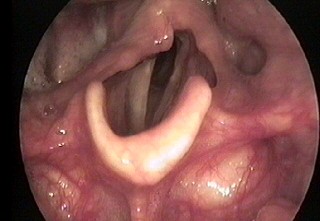What is Vocal Cord Paralysis?
 Vocal cord paralysis refers to restricted movement of the vocal cords caused by dysfunction of the nerve(s) responsible for sending signals to the vocal cord muscles. Depending on how many cords are affected, the paralysis may be unilateral (one-sided) or bilateral (both sides).
Vocal cord paralysis refers to restricted movement of the vocal cords caused by dysfunction of the nerve(s) responsible for sending signals to the vocal cord muscles. Depending on how many cords are affected, the paralysis may be unilateral (one-sided) or bilateral (both sides).
Normally, the vocal cords open during breathing and close completely during speaking, singing, or swallowing.
What is Vocal Cord Paresis/Weakness?
Vocal cord paresis (or weakness) occurs when the nerve signals to the vocal cords are reduced. In paresis, the vocal cords still move, but the movement may be limited (unable to fully open or close), or symptoms of vocal fatigue may occur after prolonged voice use.
What Symptoms Does Vocal Cord Paralysis Cause?
The symptoms vary depending on whether the paralysis is unilateral or bilateral, and whether there is complete paralysis or weakness/paresis:
- Hoarseness or change in voice quality
- Vocal fatigue or weakening of the voice while speaking
- Shortness of breath during speech, or feeling breathless
- Inability to speak loudly
- Inability to produce high-pitched sounds (loss of upper range, especially in singers)
- Throat pain or tightness while speaking
- Aspiration of food or liquids into the airway, choking and coughing
- Breathing problems and shortness of breath (seen in bilateral paralysis)
What Causes Vocal Cord Paralysis?
- Surgical injury to the nerve that controls the vocal cords, often during operations in the head, neck, or chest. Common examples include thyroid surgery, cervical spine surgery, heart, lung, or esophageal surgery, and certain brain operations. Because the nerve is very delicate, paralysis may occur even during meticulous surgery and is often unavoidable.
- Inflammatory or infectious conditions, especially viral upper respiratory infections, can affect the vocal cord nerve.
- Tumors pressing on the nerve along its long course from the brain, through the neck and chest, to the larynx. The most common tumors causing paralysis are those in the lungs.
- Intubation trauma, when the breathing tube used in general anesthesia exerts pressure on the nerve.
- Other causes include drug toxicity, neurological diseases, stroke, and systemic illnesses such as diabetes or rheumatic diseases.
How is Vocal Cord Paralysis Diagnosed?
Diagnosis is made by examining the vocal cords with videolaryngostroboscopy or flexible fiberoptic laryngoscopy. The impact of paralysis on the voice can be evaluated using acoustic voice analysis, while laryngeal EMG (electromyography) provides information about whether nerve damage is reversible.
If vocal cord paresis/weakness is suspected during examination, laryngeal EMG helps confirm the diagnosis. To determine the underlying cause, a detailed ENT examination is performed, often complemented by imaging studies such as CT or MRI scans and blood tests.
How is Vocal Cord Paralysis Treated?
The choice of treatment depends on several key factors:
- Whether the paralysis is unilateral or bilateral
- The underlying cause
- The duration of paralysis
- The position of the paralyzed vocal cord
- The severity of the patient’s symptoms
Because of these variables, treatment must be tailored to each patient individually.
Unilateral Vocal Cord Paralysis
The main treatment options for voice-related problems include:
- Voice therapy
- Injection laryngoplasty (injection of filler material into the vocal closed approach surgery)
- Thyroplasty (open framework surgery of the vocal cord)
Which option is chosen depends entirely on the individual case. The best voice outcomes are usually achieved with appropriate treatment applied in the early period after the onset of paralysis.
Bilateral Vocal Cord Paralysis
Here, the main issue is airway obstruction. Surgical procedures, usually performed through the mouth, aim to widen the narrowed airway caused by paralysis. Although voice quality worsens after surgery for bilateral paralysis, it is important to note that complete voice loss or inability to speak does not occur.
In very severe cases with significant breathing difficulty, a tracheotomy (surgical opening of the airway in the neck) may be required. This opening is often closed after subsequent oral surgery.